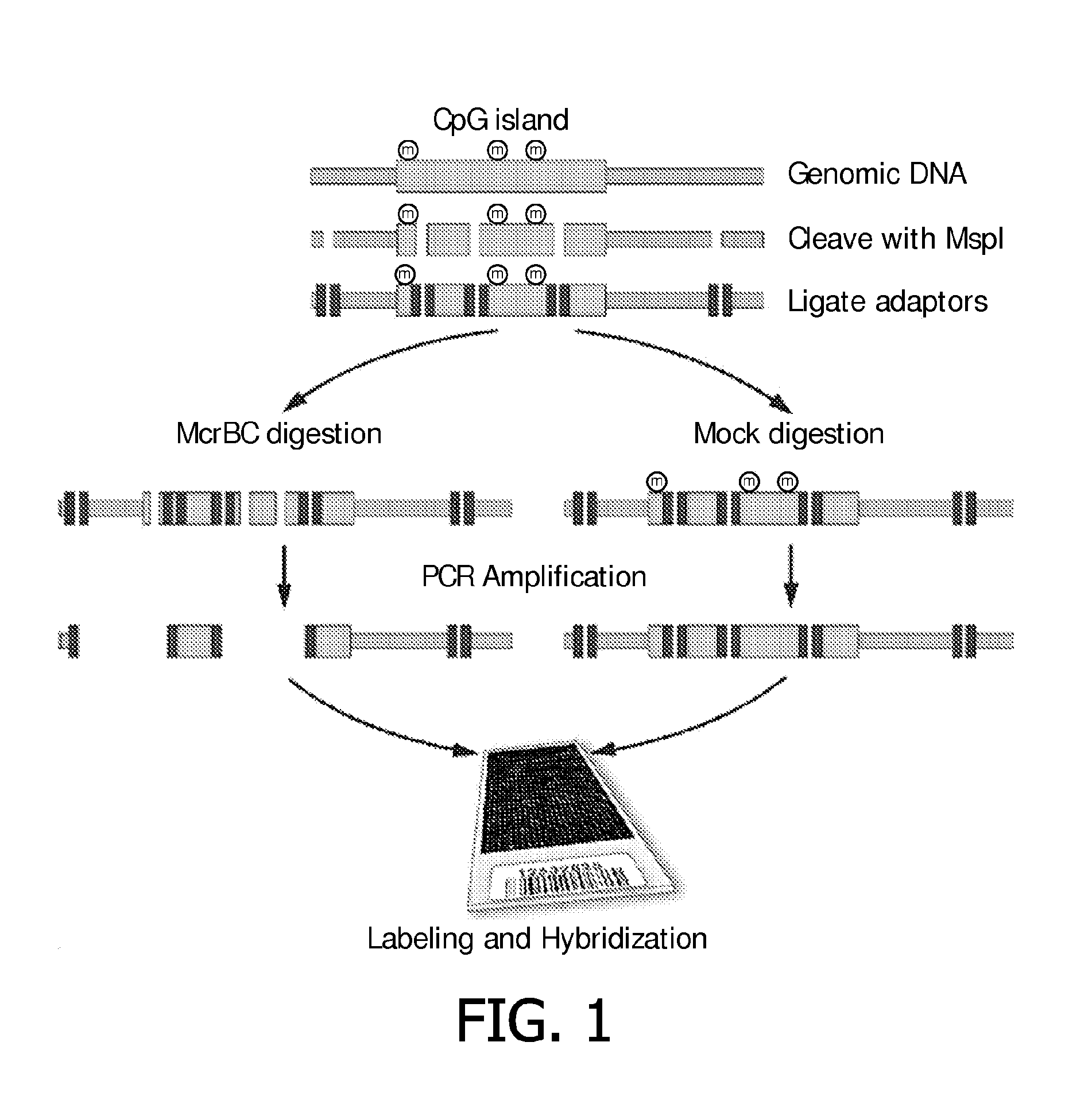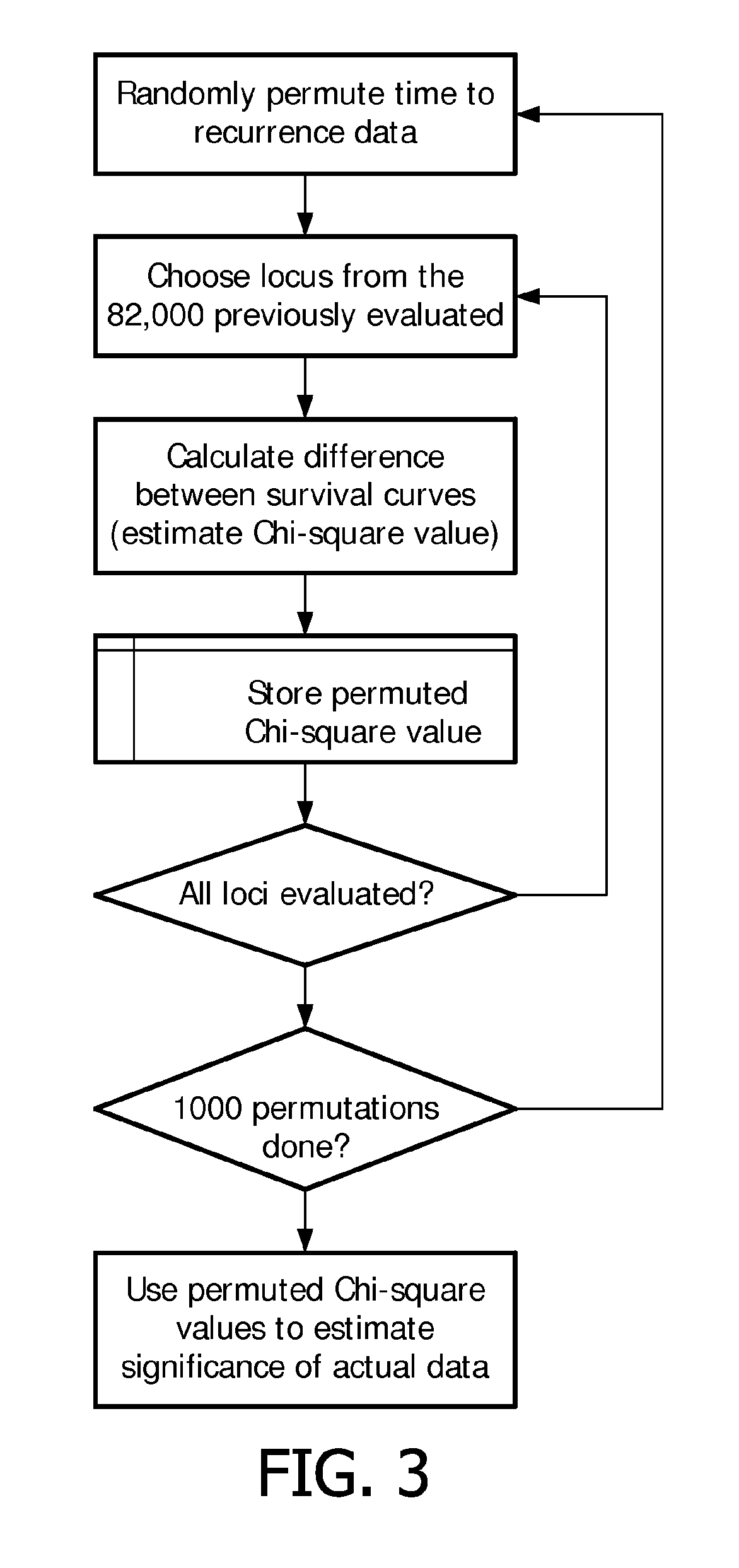Method and compositions for assisting in diagnosing and/or monitoring breast cancer progression
a breast cancer and composition technology, applied in the field of methods, can solve the problems of affecting the reliability and/or accuracy of detection, the hampered availability of diagnostic assays for analyzing breast cancer, and the inability to characterize well
- Summary
- Abstract
- Description
- Claims
- Application Information
AI Technical Summary
Benefits of technology
Problems solved by technology
Method used
Image
Examples
example 1
Design of a DNA Array for Performing Differential Methylation Analysis
[0086]The Methylation Oligonucleotide Microarray Analysis (MOMA) array used in the present invention for performing whole genome detection of differentially methylated loci was designed as follows.
[0087]The genomic DNA was digested with a restriction endonuclease with a CG rich recognition sequence (MspI), followed by ligation of adaptors for use in a subsequent step of reducing genomic complexity. One-half of the adaptor-ligated sample was depleted of its methylated sequences by digestion with the methylation specific endonuclease, McrBC, and the other half was mock-treated. Carefully balanced PCR conditions were used to size-select Mspl fragments and reduce the overall genome complexity. The McrBC treated representation was compared to the mock treated sample which serves as the reference for comparative hybridization on an oligonucleotide tiling array with 367K features with coverage of 26.219 out of 27.801 ann...
example 2
Breast Cancer Samples
[0088]DNA methylation analysis was performed for 121 human breast tumors, 108 of which had associated clinic-pathological annotations including relapse and survival data for up to 10 years.
[0089]In one embodiment, only those tumors that were Estrogen receptor positive were analyzed, a total of 70 tumors.
[0090]Each sample's methylation profile was determined by using an expectation maximization algorithm to pool each locus into one of three distinct states—unmethylated, partially methylated and methylated.
[0091]Gnomic DNA extraction from the tumor samples as well as determining the DNA methylation pattern was performed according to established standard proceedings.
example 3
Statistical Survival Model
[0092]The statistical model chosen for evaluating the probability that there would be no systemic recurrence in a given amount of time is the Kaplan-Meier estimator of the survival function.
[0093]The Kaplan-Meier estimator calculates the probability of no systemic recurrence at a given time by using the time to systemic recurrence for all the patients included in the study. Since some patients typically leave the study after a while, the Kaplan-Meier estimator accounts for the loss of patients from the study at different points in time due to lack of follow-up. This is called the “censoring problem” in survival analysis and is already accounted for in the Kaplan-Meier estimator. The Kaplan-Meier estimator was used to analyze the probability of no systemic recurrence over a period of 10 years after initial diagnosis. The procedure for identifying genomic loci that have potential prognostic value for diagnosing and / or monitoring breast cancer is schematically...
PUM
| Property | Measurement | Unit |
|---|---|---|
| Time | aaaaa | aaaaa |
Abstract
Description
Claims
Application Information
 Login to View More
Login to View More - R&D
- Intellectual Property
- Life Sciences
- Materials
- Tech Scout
- Unparalleled Data Quality
- Higher Quality Content
- 60% Fewer Hallucinations
Browse by: Latest US Patents, China's latest patents, Technical Efficacy Thesaurus, Application Domain, Technology Topic, Popular Technical Reports.
© 2025 PatSnap. All rights reserved.Legal|Privacy policy|Modern Slavery Act Transparency Statement|Sitemap|About US| Contact US: help@patsnap.com



